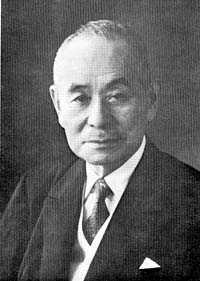Yoshiaki Hatta
| Yoshiaki Hatta 八田 嘉明 | |
|---|---|
 | |
| Born |
September 14, 1879 Tokyo, Japan |
| Died | April 26, 1964 (aged 84) |
| Nationality | Japan |
| Occupation | Entrepreneur, Engineer, Cabinet Minister |
Yoshiaki Hatta (八田 嘉明 Hatta Yoshiaki , September 14, 1879 – April 26, 1964), was an engineer, entrepreneur, politician and cabinet minister in the Empire of Japan, serving as a member of the Upper House of the Diet of Japan, and five times as a cabinet minister.
Biography
Hatta was born in Tokyo, and was a graduate from Tokyo Imperial University with a degree in civil engineering. He was employed by the San'yō Railway from 1903. However, he was recruited into the government bureaucracy, and transferred a position within the Railroad Bureau of the Ministry of Communications in 1906. After the Railway Ministry was created, Hatta was appointed a Director in 1926. He was further awarded with a seat in the House of Peers from 1929.
With the creation of the South Manchurian Railway Company (SMR), Hatta was appointed Vice President in 1932. He reorganized the management of the SMR, favoring increased cooperation with the Kwantung Army after the Manchurian Incident. [1] He also encouraged French investment in the construction of the new capital of Manchukuo, Shinkyo [2]
In 1934, under the Hiranuma administration, Hatta was asked to serve as both Minister of Commerce and as Minister of Colonial Affairs. He was also made head of the The Japan Chamber of Commerce and Industry and the Tokyo Chamber of Commerce and Industry.
In 1941, many small private railway companies were merged under government pressure into the Tobu Railway, as per the syndicalist economic policies of the Taisei Yokusankai. Hatta was appointed Chairman of the Board of the expanded company. In 1943, he was asked to serve again as Minister of Communications and Railroad Minister, this time under the Tōjō administration. During this administration, the two cabinet-level posts were merged into the new Ministry of Transport and Communications in 1943, and Hatta became the first head of the combined ministry. In 1945, Hatta became president of the North China Development Company, a subsidiary of the South Manchurian Railway dedicated to the economic development of the areas of northern China under occupation by Japan.
Following the surrender of Japan and the end of World War II, Hatta was purged from public office by the Supreme Commander of the Allied Powers. In 1953, he became president of Takushoku University, a post which he held to September 1954.[3] In 1955, he became president of Nippei Kōsan Corporation, and Chairman of the Japan Science Foundation. In 1956, he founded the Nippon Gijustu Kyōwa Kaihatsu Corporation, and in 1957 he was named chairman of the forerunner to the Japan Highway Public Corporation. Hatta died in 1964.
References
- Ito, Takeo. Life Along the South Manchurian Railway: The Memoirs of Itō Takeo. M E Sharpe (1988). ISBN 087332465X.
- Victoir, Laura. Harbin to Hanoi: The Colonial Built Environment in Asia, 1840 to 1940. Hong Kong University Press (2013). ISBN988813941X
Notes
- ↑ Ito. Life along the South Manchurian Railway. page 156.
- ↑ Victoir. Harbin to Hanoi. page 69.
- ↑ Takushoku University home page
| Political offices | ||
|---|---|---|
| Preceded by -none- |
Minister of Transport and Communications Nov 1943 - Feb 1944 |
Succeeded by Keita Gotō |
| Preceded by Ken Terajima |
Minister of Communications Oct 1941 - Oct 1943 |
Succeeded by abolished |
| Preceded by Ken Terajima |
Minister of Railways Dec 1941 - Nov 1943 |
Succeeded by abolished |
| Preceded by Shigeaki Ikeda |
Minister of Commerce and Industry Jan 1939 - Aug 1939 |
Succeeded by Takuo Godō |
| Preceded by Fumimaro Konoe |
Minister of Colonial Affairs Oct 1938 - Apr 1939 |
Succeeded by Kuniaki Koiso |